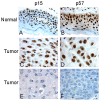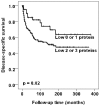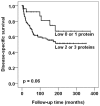Expression of p15INK⁴b and p57KIP² and relationship with clinicopathological features and prognosis in patients with vulvar squamous cell carcinoma
- PMID: 23580324
- PMCID: PMC3620337
- DOI: 10.1371/journal.pone.0061273
Expression of p15INK⁴b and p57KIP² and relationship with clinicopathological features and prognosis in patients with vulvar squamous cell carcinoma
Abstract
Background: The cyclin-dependent kinase inhibitors p15(INK4b) and p57(KIP2) are important regulators of the cell cycle, and their abnormal expression has been detected in various tumors. However, little is known about the role of p15(INK4b) and p57(KIP2) in the pathogenesis of vulvar carcinoma, and the prognostic impact is still unknown. In our current study, we examined the expression of p15(INK4b) and p57(KIP2) in a large series of vulvar squamous cell carcinomas to elucidate the prognostic impact.
Methods: Expression of p15(INK4b) and p57(KIP2) were examined in 297 vulvar squamous cell carcinomas using immunohistochemistry. Both uni- and multivariate analysis of prognostic factors were performed, and correlations with clinicopathologic parameters were examined.
Results: Compared to the high levels of p15(INK4b) and p57(KIP2) in normal vulvar squamous epithelium, low levels of p15(INK4b) and p57(KIP2) were found in 82% and 44% of vulvar carcinomas, respectively. Low levels of p15(INK4b) and p57(KIP2) correlated significantly with malignant features, including large tumor diameter (p = 0.03 and p = 0.001, respectively) and increased invasiveness (p = 0.003 and p = 0.04, respectively). Although p15(INK4b) and p57(KIP2) levels could not be identified as prognostic markers, combined analysis of p14(ARF)/p15(INK4b)/p16(INK4a) showed that patients whose tumors expressed low levels of two or three of these INK4 proteins had a worse prognosis than those with only low levels of one or no protein (univariate analysis p = 0.02). The independent prognostic significance of these INK4 proteins was confirmed by multivariate analysis (p = 0.008).
Conclusions: We show for the first time that p15(INK4b) and p57(KIP2) may be involved in the progression of vulvar carcinomas and the combined p14(ARF)/p15(INK4b)/p16(INK4a) status was a statistically independent prognostic factor.
Conflict of interest statement
Figures



Similar articles
-
Prognostic significance of p14ARF, p15INK4b, and p16INK4a inactivation in malignant peripheral nerve sheath tumors.Clin Cancer Res. 2011 Jun 1;17(11):3771-82. doi: 10.1158/1078-0432.CCR-10-2393. Epub 2011 Jan 24. Clin Cancer Res. 2011. PMID: 21262917
-
A potential role for p15(Ink4b) and p57(Kip2) in liver development.FEBS Lett. 2000 Oct 20;483(2-3):160-4. doi: 10.1016/s0014-5793(00)02108-6. FEBS Lett. 2000. PMID: 11042273
-
The prognostic significance of p16(INK4a)/p14(ARF) locus deletion and MDM-2 protein expression in adult acute myelogenous leukemia.Cancer. 2000 Nov 1;89(9):1976-82. doi: 10.1002/1097-0142(20001101)89:9<1976::aid-cncr14>3.3.co;2-e. Cancer. 2000. PMID: 11064355
-
The regulation of INK4/ARF in cancer and aging.Cell. 2006 Oct 20;127(2):265-75. doi: 10.1016/j.cell.2006.10.003. Cell. 2006. PMID: 17055429 Review.
-
A clinicopathological review of 33 patients with vulvar melanoma identifies c-KIT as a prognostic marker.Int J Mol Med. 2014 Apr;33(4):784-94. doi: 10.3892/ijmm.2014.1659. Epub 2014 Feb 14. Int J Mol Med. 2014. PMID: 24535703 Free PMC article. Review.
Cited by
-
Does cyclin E and p57kıp2 expression have prognostic and survival value in colorectal adenocarcinoma?Int J Clin Exp Pathol. 2018 Aug 1;11(8):3867-3875. eCollection 2018. Int J Clin Exp Pathol. 2018. PMID: 31949774 Free PMC article.
-
Expression of CDK1(Tyr15), pCDK1(Thr161), Cyclin B1 (total) and pCyclin B1(Ser126) in vulvar squamous cell carcinoma and their relations with clinicopatological features and prognosis.PLoS One. 2015 Apr 7;10(4):e0121398. doi: 10.1371/journal.pone.0121398. eCollection 2015. PLoS One. 2015. PMID: 25849598 Free PMC article. Clinical Trial.
-
Variable Expression of Oncogene-Induced Senescence/SASP Surrogates in HPV-Associated Precancerous Cervical Tissue.Curr Issues Mol Biol. 2024 Dec 2;46(12):13696-13712. doi: 10.3390/cimb46120818. Curr Issues Mol Biol. 2024. PMID: 39727946 Free PMC article.
References
-
- Coulter J, Gleeson N (2003) Local and regional recurrence of vulval cancer: management dilemmas. Best Pract Res Clin Obstet Gynaecol 17: 663–681. - PubMed
-
- Giles GG, Kneale BL (1995) Vulvar cancer: the Cinderella of gynaecological oncology. Aust N Z J Obstet Gynaecol 35: 71–75. - PubMed
-
- Jones RW, Baranyai J, Stables S (1997) Trends in squamous cell carcinoma of the vulva: the influence of vulvar intraepithelial neoplasia. Obstet Gynecol 90: 448–452. - PubMed
-
- Messing MJ, Gallup DG (1995) Carcinoma of the vulva in young women. Obstet Gynecol 86: 51–54. - PubMed
-
- Sherr CJ, Roberts JM (1999) CDK inhibitors: positive and negative regulators of G1-phase progression. Genes Dev 13: 1501–1512. - PubMed
Publication types
MeSH terms
Substances
LinkOut - more resources
Full Text Sources
Other Literature Sources
Medical
Research Materials

